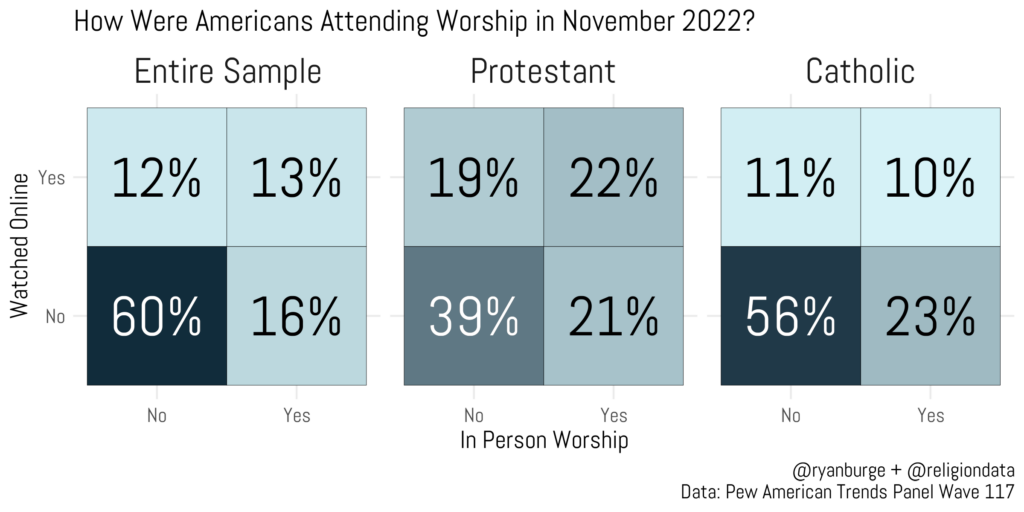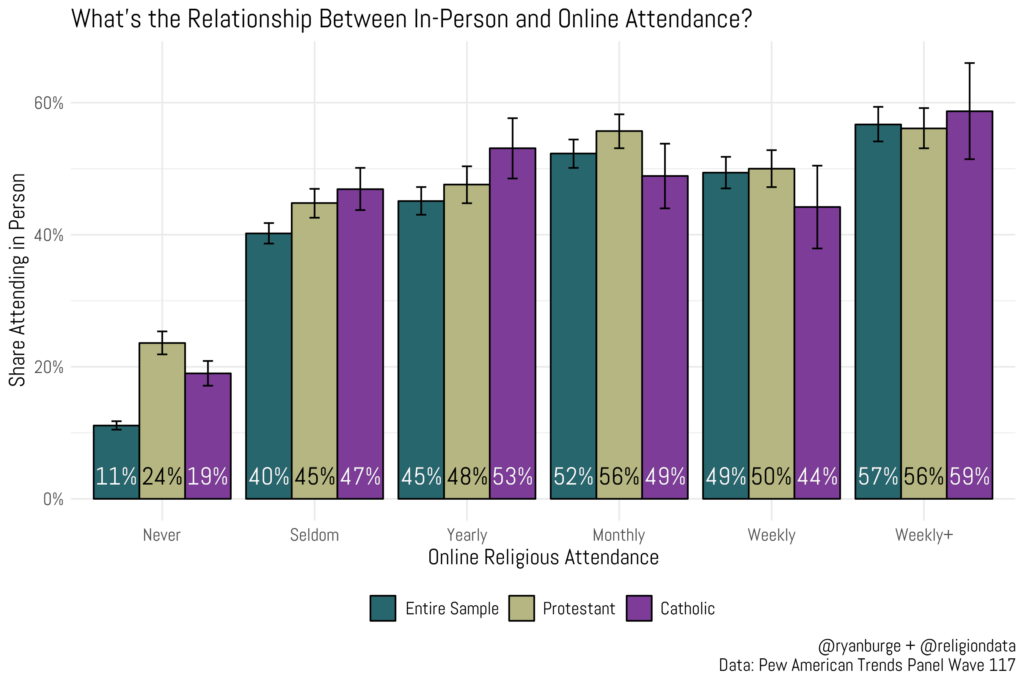
CV NEWS FEED // Data from a 2022 Pew Research Center poll show that online worship does not detract from in-person church attendance. Those who attend church several times a week are more likely to also watch services online.
Statistician Ryan Burge, who is also a Baptist pastor, analyzed data from a 2022 survey that asked over 11,000 people several questions about their church attendance habits. According to the data, 60% of the entire sample said they hadn’t attended a church service either online or in person in the last month.
Twelve percent said they watched online but didn’t worship in person, 13% said they did both, and 16% said that they attended a church service in person and didn’t watch online.

“[P]eople were just as likely to do both as they were to do only one,” Burge noted. “And there’s no evidence here that a whole bunch of people are online only – it was just 12% of the total survey sample.”
Burge also tracked the data from Protestant and Catholic responses, finding that 40% of Protestants and 56% of Catholics hadn’t attended a service in-person or online in the last month.

Protestants were just as likely to attend services exclusively in-person (21%) as they were to attend online (19%), but Catholics were twice as likely to attend Mass in-person (23%) than they were to watch it online (11%).
“Pretty clear evidence here that online church is just not as pervasive among Catholics as it is among Protestants,” Burge noted.
Burge then asked if going to a religious service in person would “crowd out” the other option of going online, or vice versa.
“If people feel like they need to “check a box” when it comes to religious attendance, it would seem that one would crowd out the other,” he wrote. “But that’s not at all what the data indicates.”
According to the data, the people who went to in-person services several times a week were the most likely to watch online services as well (57%). Those who went in-person monthly or weekly also were more likely to watch online services than those who seldom or never went to services in person.
Another difference between Catholic and Protestant attendance also became clear, as the graph showed that among Protestants attending in-person services weekly, 50% still watched online. For Catholics going to weekly Mass, only 36% watched online as well.
When the question was flipped—asking if those who regularly attended online services ever went to in-person religious services—the data remained much the same.

“This data points to a pretty unmistakable conclusion – there is no crowding out effect when it comes to virtual attendance,” Burge wrote, adding:
Said another way, virtual worship seems to be little more than an add on effect for people who are already religiously engaged. People who don’t attend that much aren’t filling that void with online services. At least not in huge numbers.
Burge also checked to see if younger generations preferred online services over in-person worship. Nineteen percent of people aged 18-29 said they preferred church services to be online; 11% of people aged 30-49 said the same; 11% of those aged 50-64 agreed; and just 3% of those aged 65 or older also said the same.

While the younger generation was slightly more likely than other generations to say that worship was better online, the majority of every age group still preferred in-person services. Of the total sample, only 11% said online services were better, but 76% said in-person worship was preferable.
Finally, Burge singled out the respondents who said that they watched online services at least once a week but only went to in-person services once a year or less—a group that made up only 4.8% of the entire sample.

The majority of entirely virtual online worshippers were people aged 65 or older (35%) and people aged 50-64 (34%). Those who watched online services were more likely to have high school as their highest level of completed education (35%). A small number (8%) didn’t go to high school at all.
When compared with the percentages of the overall sample, Burge found that 27% of online worshippers were African-American, more than twice the rate of the entire sample (12%). Other races, such as White, Hispanic, and Asian, tended to be more likely to go to church in person when compared to the overall sample.
Burge concluded by reminding church ministers that their service livestreams generally aren’t being watched by those who exclusively stay home to worship, but that online services can be a useful tool nonetheless.
“I am certainly not advocating that thousands of churches should pull the plug on their livestream this weekend,” he added. “But I do think it’s helpful for them to see what they are dealing with when it comes to this new type of church member.”

